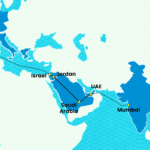
Does India’s purported success at the G20 summit – particularly the India-Middle-East-Europe-Economic-Corridor (IMEEC) proposal – solidify ideas of the nation’s future or its past?
Historian William Dalrymple – with an uncanny knack for tracing historical correlates in a dynamic present – indicates how the corridor is reminiscent of the historical route once in vogue for East-West trade through the Gulf of Aden and the Red Sea, until about the 14th century. Today, historical paradigms may well be tilting towards a reprisal of Indo-Middle-Eastern-European civilisational narratives.
Since the IMEEC proposal was floated, geopolitical pundits have speculated whether the trade route might counteract the Chinese Belt and Road Initiative (BRI). What can be said, with academic objectivity, is that the idea of the transcontinental shipping and railway corridor militates against the currency of the “Silk Road” – that constituted Eurasian trade networks, roughly between 200 BC and 1400 AD.
Counteracting Chinese Civilisational Rhetoric
The overbearing “Silk Road” discourse is monopolising perceptions of old Eurasian trading routes as revolving around romantic images of goods-laden camel caravans from China into Europe and Rome. This archetype also bolsters the lexicon of Chinese political rhetoric that harks back to an ancient Chinese civilisation.
However, the notion of the Silk Road or Silk Route is fairly recent. It recapitulates the coinage of the German concept, Seidenstraße (literally Silk Road), popularised in Europe by the German traveller, Ferdinand von Richthofen, in the 1870s. The term found wider currency with the publication of Swedish geographer Sven Hedin’s book, The Silk Road in 1938.
In stark contrast, memories of the Indo-Middle-Eastern-Greco-Roman trade were alive in 18th- and 19th-century European and Indian consciousness as a reminder of Eurasian trade routes via the Red Sea.
British colonial records from 19th century suggest that modern Europe was palpably aware of the ancient Greco-Roman-Indian spice-and-goods trade (including wine, wool, sauces, gemstones, and corals) between India and Rome, with anchorages like Bharuch (in Gujarat) and Muziris (in the Konkan-Malabar region) being globally important ports.
This is further supported by excavations at Alexandria and other Egyptian artefacts pertaining to ancient Indian religious sculpture. Like the Chinese, Greco-Roman-Indian links and India’s traffic of ideas with Persia and the Middle East, since, at least, Mauryan times (circa 320 BC) is a vital aspect of Indian civilisational political rhetoric.
However, the history requires clear-sighted dissemination by politically unaligned historians. The consonance between Greco-Roman-Persian and Jain and Buddhist cultures commands is an equally important motif in that history.
Historical And Geopolitical Complexity
The IMEEC corridor has crystallised a churn in contemporary geopolitics which would be naïve to either peremptorily ignore or celebrate. The European and Saudi involvement cannot be delinked from their economic and political affinities with the United States, while Saudi Arabia’s economic ties with China are well known and a subject of much geostrategic brainstorming for America.
The American zeal to counteract Chinese influence in the Middle East is paralleled by India’s International North-South Transport Corridor agreements with Russia, Iran, and Azerbaijan, on a trade route traversing the Persian Gulf and the neighbourhood of the Caspian Sea. While the United States balances China and other powers, Indian trade has sought to juggle America and China, keeping an eye out for the maritime passage between Israel and Greece.
India’s so-called rising stature on the global platform needs to be viewed against the prism of a potentially perplexing geopolitical geometry not only in the eyes of India but also America, Europe, Russia, and China.
This sobering reality is further sobered as one encounters the geopolitical realism of India’s railway history. A key motivation behind Britain building railroads in colonial India was to secure British possessions from Canada to Hong Kong, both via the Red Sea and the Persian Gulf – not to mention the counteraction of Russia’s military and political influence in Central Asia.
Intermeshing the economies of Europe and British India was virtually the ruse to intermesh the military clout of Britain and its South Asian colonies against the Russian Empire. Whether or not the Indian state is conscious of it, the IMEEC’s history recalls colonial India’s first railway planner, R MacDonald Stephenson and, his imperial partner, the Bengali industrialist and founder of the Great Western of Bengal Railway Company, Dwarkanath Tagore.
The Long Road Back to Muziris
It is important to recognise, then, that geopolitics is only one of several ways to observe the IMEEC. For South Asian history, the IMEEC may prove to be a throwback to many other kinds of lost legacies, including Indo-Lankan and Indo-South-East-Asian trade routes, across the famous Pearl Fisheries near Adam’s Bridge; and, of course, the lost harbour of Muziris, once an Indian emporium for European civilisations.
Arguably, India and Sri Lanka were once connected with a shallow trade route, across the Palk Strait, which is said to have been damaged by a cyclone, around 1480, according to the records of the Rameswaram Temple; later corroborated by Dutch and British colonial records. The Pamban Bridge (now closed to traffic), constructed by the Madras government and the South Indian Railway in 1914, emphatically recapitulated the civilisational route between India and Ceylon (or Taprobane) leveraged by legendary ancestors.
As for Muziris (Muchiri or Murachipattanam), the port that mysteriously disappeared around the 14th century, the jury is still out whether it was in and around Mangalore (Karnataka) or Pattanam (Kerala).
Raised well, questions of India’s past can certainly have a profound impact on its future, just as the notion of the Silk Route influenced China’s economy and cultural hegemony. It will not be surprising to find South Asian historians on their toes too, sculpting their consciousness of ancient trade routes to a significantly older Indian paradigm.
Questions of India’s perceived economic resurgence aside, the long road back to Muziris is here to stay as a dominant historical alternative to China’s Silk Route.


